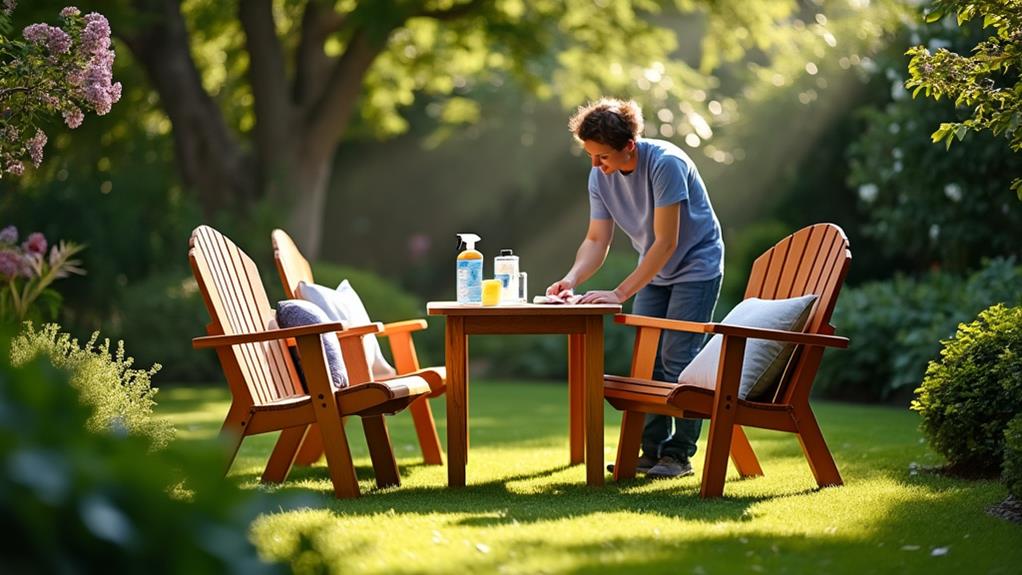To keep your outdoor furniture in top condition, regular maintenance is essential. Start by cleaning with mild soap, water, and a soft brush to remove debris and prevent surface damage. For metal pieces, apply rust inhibitors and inspect for corrosion, while wooden furniture benefits from an annual application of sealant to resist UV damage and moisture. Conduct routine inspections to identify loose screws or broken parts, ensuring safety and durability. Use protective covers and store cushions indoors when not in use. Adapting care based on seasonal changes will further extend the lifespan of your setup, uncovering more effective strategies to protect your investment.
Importance of Regular Maintenance
Taking care of your outdoor furniture is vital for its longevity and enjoyment. Regular maintenance plays an important role in preserving both the aesthetic and functional quality of your pieces.
By minimizing weathering effects, you can extend the lifespan of your furniture considerably. Conducting timely inspections and repairs prevents further damage and enhances safety.
You'll want to commit to consistent maintenance to guarantee your outdoor spaces remain inviting and enjoyable for years. Regular checks help identify loose screws or bolts, allowing you to tighten them before they become a safety concern.
Effective Cleaning Techniques
When it comes to cleaning your outdoor furniture, gathering the right supplies is your first step towards maintaining its appearance and durability. Start with essentials like mild soap, water, a soft brush or sponge, and a hose.
Clean your furniture at least once per season, especially after heavy use or exposure to harsh weather. Begin by removing any loose debris such as dirt, dust, or leaves with a brush or broom.
Mix a cleaning solution using mild soap and water, ensuring not to use excess soap. Rinse thoroughly to avoid soap residue buildup, then dry completely to prevent corrosion.
Avoid abrasive cleaners, as they can scratch surfaces. Consistent cleaning will help preserve your furniture's aesthetic and structural integrity.
Protecting Different Materials
Shielding your outdoor furniture from the elements is key to maintaining its condition and appearance. Different materials require specific protection strategies to guarantee longevity.
Metal furniture, for instance, benefits from rust inhibitors that create a barrier against moisture. For wood, applying a high-quality sealant protects against UV rays and dampness. Covering furniture when not in use helps shield it from harsh weather, and storing cushions indoors prevents mildew and moisture buildup.
- Metal: Use rust inhibitors, inspect and remove rust with a wire brush or sandpaper.
- Wood: Apply a sealant annually, following the manufacturer's instructions.
- Covers: Use to protect from weather elements.
- Cushions: Store indoors, ensuring they're clean and dry.
Adhering to these strategies guarantees your furniture's preservation.
Routine Inspections and Checks
Someone might overlook the importance of regular inspections, but keeping a routine check on your outdoor furniture is essential.
Begin by examining your furniture for loose screws, bolts, or fasteners, guaranteeing everything is tightened without overtightening. This simple step maintains stability and prevents accidents.
Look for cracked or broken parts, especially in wooden pieces where rot or decay may occur. Conduct these checks periodically, especially after severe weather or heavy use, to identify potential issues early.
Keeping furniture off the ground helps prevent moisture absorption, which can lead to damage over time. Utilize furniture pads to prevent surface scratches.
Regular inspections not only prolong your furniture's life but also guarantee a safe and pleasant outdoor space for everyone.
Repair and Replacement Options
After a thorough inspection, you might find parts of your outdoor furniture that need repair or replacement. To address these issues effectively, start by measuring or photographing the damaged components. This guarantees you get the right replacements.
Consider these practical steps:
- Contact the manufacturer: They might've original replacement parts.
- Explore online resources: Websites often offer a wide variety of parts and accessories.
- Consult local repair specialists: They might provide tailored solutions.
- Consider DIY repairs: For minor issues, if you have the necessary skills.
These options help maintain the integrity and appearance of your furniture.
Always keep a record of your furniture's specifications. This simplifies sourcing replacements and guarantees you choose parts that fit perfectly.
Seasonal Care Guidelines
While addressing repair and replacement needs can restore your outdoor furniture, incorporating seasonal care into your routine guarantees it remains in top condition throughout the year.
Begin by adjusting care practices based on seasonal weather changes. In spring, thoroughly clean your furniture to remove winter residue, and inspect for any damage.
Summer care includes regular cleaning, especially after rain, to prevent mildew. Use breathable covers to protect against harsh sunlight.
In autumn, remove leaves and debris promptly to avoid staining. Before winter, store lightweight pieces indoors and cover heavier items, ensuring they're dry.
Apply rust inhibitors to metal components and sealants to wood surfaces. These practices help maintain structural integrity and aesthetic appeal, ensuring your furniture withstands seasonal challenges.
Enhancing Longevity and Safety
To enhance the longevity and safety of your outdoor furniture, prioritize regular inspections and maintenance. By doing so, you can identify and fix issues before they become major problems.
Start by inspecting for loose screws or bolts, tightening them to guarantee stability. Look for cracked or broken components, especially in wooden pieces, to prevent further damage.
Keep your furniture elevated to avoid moisture absorption, which can lead to rot or decay. Incorporating these practices can help maintain your furniture's integrity over time.
- Inspect frequently for loose or damaged parts.
- Tighten screws to maintain stability.
- Elevate furniture to prevent moisture damage.
- Replace or repair any compromised components.
These steps will safeguard your outdoor furniture, guaranteeing both its safety and extended lifespan.


